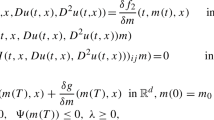Abstract
A model of competitive innovation diffusion is considered. The model is based on the Lotka-Volterra system and an initial-boundary problem for a system of quasilinear parabolic equations. The maximum principle is proved for the problem of diffusion of two competitive innovations, and sufficient conditions of existence of optimum control are obtained for the system. A numerical algorithm is constructed for solving optimum control problems, and numerical results for a model example are presented.
Similar content being viewed by others
References
V. O. Vasilenko and V. G. Shmatko, Innovative Management [in Ukrainian], TsUL, Feniks, Kiev (2003).
V. Moskovkin, “Fundamentals of the concept of innovation diffusion,” Business-Inform., Nos. 17–18, 41–48 (1998).
J. A. Schumpeter, The Theory of Economic Development [Russian translation], Progress, Moscow (1982).
V. V. Akimenko and I. I. Sugonyak, “Dynamic models of life cycles of innovations under uncertainty,” Visn. Kyiv. Un-tu., Ser. Fiz.-Mat. Nauky, No. 3, 35–46 (2007).
O. A. Ladyzhenskaya, V. A. Solonnikov, and N. N. Uraltseva, Linear and Quasilinear Parabolic Equations [in Russian], Nauka, Moscow (1967).
V. P. Mikhailov, Partial Differential Equations [in Russian], Nauka, Moscow (1983).
J. L. Menaldi, E. Rofman, and A. Sulem, “Optimal control and partial differential equations,” Innovations & Applications, IOS Press, Amsterdam (2001).
K. Kunisch, G. Leugering, J. Sprekels, and F. Troltzsch, “Control of coupled partial differential equations,” Intern. Ser. of Numer. Math., 155, No. 6, Springer-Birkhauser (2007).
V. V. Akimenko and A. G. Nakonechnyi, “Optimal control models for interregional migration under social risks,” Cybernetics and Systems Analysis, No. 3, 107–122 (2006).
A. N. Kolmogorov and S. V. Fomin, Elements of the Theory of Functions and Functional Analysis [in Russian], Nauka, Moscow (1989).
A. A. Samarskii, Theory of Difference Schemes [in Russian], Nauka, Moscow (1989).
V. V. Akimenko, “Simulation of Two-Dimensional Transport Processes Using Nonlinear Monotone Second-Order Schemes,” Cybernetics and Systems Analysis, No. 6, 75–93 (2003).
V. V. Akimenko, “The maximum principle and nonlinear monotonic schemes for parabolic equations,” Zh. Vychisl. Mat. Mat. Fiz., 39, No. 4, 618–629 (1999).
V. V. Akimenko and O. K. Cheremnykh, “Modeling of vortex flows against the background of a two-dimensional process of convective heat-mass exchange,” Probl. Upravlen. Inf., No. 2, 64–80 (2004).
I. V. Sergienko and V. P. Shilo, Discrete Optimization Problems [in Russian], Naukova Dumka, Kiev (2003).
Author information
Authors and Affiliations
Additional information
__________
Translated from Kibernetika i Sistemnyi Analiz, No. 4, pp. 120–133, July–August 2008.
Rights and permissions
About this article
Cite this article
Akimenko, V.V., Sugonyak, I.I. A model of optimal control over a nonlinear multidimensional innovation diffusion process. Cybern Syst Anal 44, 564–574 (2008). https://doi.org/10.1007/s10559-008-9027-7
Received:
Published:
Issue Date:
DOI: https://doi.org/10.1007/s10559-008-9027-7



